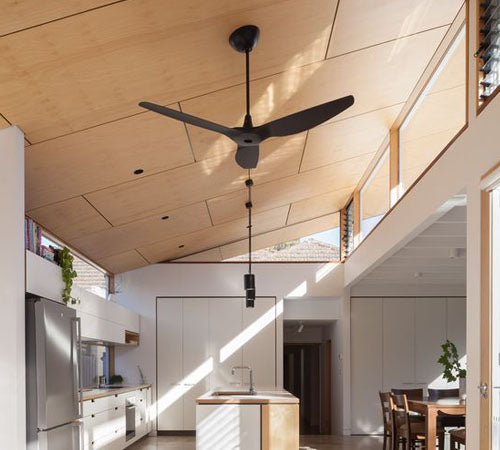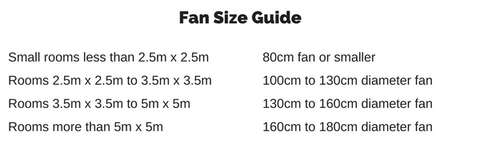What To Consider When Purchasing A Ceiling Fan

The weather is heating up which means it is time to start looking at options for cooling down your house. Since it's invention in 1888, the electrically powered ceiling fan has become one of the most popular and sensible solutions to keep a house cool (or warm. Yes, ceiling fans can actually be used in winter!). When choosing a ceiling fan there are several key factors to consider involving both the fan and where you intend to place it.
Size
A fan that is too large will make a room feel smaller and impose on the design of the room however a fan that is too small won't circulate the air properly. The table below is an approximate guide for room sizes and the fan sizes that suit them. If a room is larger then two fans may be required if no other cooling system has been put in place. The architecture of a room is also important to consider as well as the placement of certain features such as windows and doors which will affect the impact of a running fan. Generally a fan is placed in the middle of a room for symmetry but if that isn't an option, ensuring it is positioned an equal distance away from walls or over a living space will ensure the room still flows well.

(Sizes converted from Live Brighter)

A fan placed directly on top of a living space such as a bed will offer the most effective cooling. See more of our indoor fans here.
(Image via Pinterest)
Ceiling Height
Ensuring your fan is placed at a safe height is very important however placing a fan too close to the ceiling can affect the air movement and make the fan ineffective. Ceiling fans should be atleast 2.5m from the floor to accommodate for tall guests and carrying or moving long objects. If you have low ceilings a fan should sit flush against the ceiling however if you have angled or high ceilings a down rod can be added.

(Image via Live Brighter)

This cathedral ceiling uses down rods to ensure the best air flow from their fans.
(Image via Pinterest)
Lighting
It is very necessary to take lighting into account when choosing a ceiling fan for the following reasons; Do you need the fan to have an inbuilt light? Will the fan create shadows if placed in a certain spot? Will the air flow affect any hanging lights? If you are considering purchasing a fan with a light consider the type of light bulb used as well. Does it need to be long lasting? Will it be the only light in the room therefore it needs to be bright? Will the light work without needing the fan turned on? These should all be carefully considered in the design stage.

Using pendant lights with down rods decreases the effect of the fans movement on the lights as well as being placed at the same height.
(Image via Pinterest)
Style
No longer just in the clinical white colour of the past, ceiling fans have evolved to become a design statement. Different finishes, colours and materials are available to ensure you find the perfect fan for your interior design style. They also come in unique designs for example having two fan heads on one down rod or facing vertically instead of horizontally. Choose a ceiling fan to blend in seamlessly to your room or to become a bold design feature.

This two headed ceiling fan in an antique bronze perfectly compliments this industrial urban style room. Get the look with our Acqua Ceiling Fan - Wooden Blades.
(Image via Pinterest)
Use
Ceiling fans are fast becoming a popular outdoor area item as people choose to bring the indoors, outdoors. When choosing a fan for outdoors, it is essential that it has a certain wet rating making it safe for outdoor use. A damp rated fan is suitable for undercover areas which are not exposed to rain whilst a wet rated fan is suitable for open area use or use in salt air environments. Higher ratings mean more protection against weather. Many fans now come with protection against corrosion and UV rays as well as water protection.

Outdoor ceiling fans are great for humid areas such as far north Queensland and Western Australia. See our range of outdoor fans here.
(Image via Pinterest)
Remember that the best way to choose the perfect fan is research. Each room and fan is different so make sure you make an informed purchase so you can begin enjoying the benefits of this marvelous invention.

















































